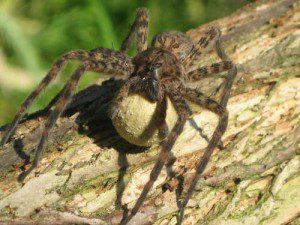It’s a Wolf Spider, Not a Tarantula
By Chris Williams on March 24, 2016.

Wolf spider carries her egg sac
Pest Management Professional magazine recently conducted a survey of its readers about spider pests that they deal with on the job. The number one spider pest in the U.S. is apparently the American house spider. Coming in at number two is the wolf spider. You’ve seen wolf spiders. If you had to pick the scariest-looking spider out of a spider lineup, you would probably pick the wolf spider. It’s relatively large and it’s hairy and it moves quickly.
To a lot of people, wolf spiders look like tarantulas. Of course, even the biggest wolf spider, at 1-1/2 inches long, is still considerably smaller than a tarantula. When people insist that they have a tarantula in their house, we have to point out again that tarantulas don’t occur in the Northeast so that is very unlikely (see, Yes, We Have No Tarantulas in New Hampshire).
Home is What You Carry on Your Back
The wolf spider doesn’t have a web like most other household spiders. That makes it seem like the spider appeared out of nowhere with no advance warning. Because she doesn’t have a web, she carries her egg sac with her. After the baby spiders are born, she carries them, too. If you think a wolf spider alone is creepy, wait until you see one with dozens of little spiders riding on its back. Even creepier, when the mother is disturbed, the spiderlings scatter, giving the impression that the big spider exploded into lots of little spiders!
Why do wolf spiders get into homes? For the same reason as any other spider, they are looking for insect prey, although sometimes they are carried in on firewood. Outside, most wolf spiders live in ground burrows or in depressions under rocks or logs. If you consider the fact that wolf spiders are very common outdoors, it figures that one will get inside from time to time.
Spiders Indoors Can Mean an Insect Problem
Because they don’t have webs, wolf spiders can be found anywhere once indoors but are usually found during the day resting under boxes or other items. The wolf spider is an active nighttime hunter. Wolf spiders might bite defensively if handled.
If you’ve only seen a single wolf spider in your home, the best thing to do is to scoot it back outdoors (they are beneficial, after all). Finding one wolf spider does not mean that there are others. If you have lots of wolf spiders indoors it may mean that you have a pest problem of another sort that is attracting and feeding the spiders. Give Colonial a call and check out this blog, How Can I Get Rid of Spiders in My Home?
Photo Credit : U.S. Department of the Interior | U.S. Geological Survey